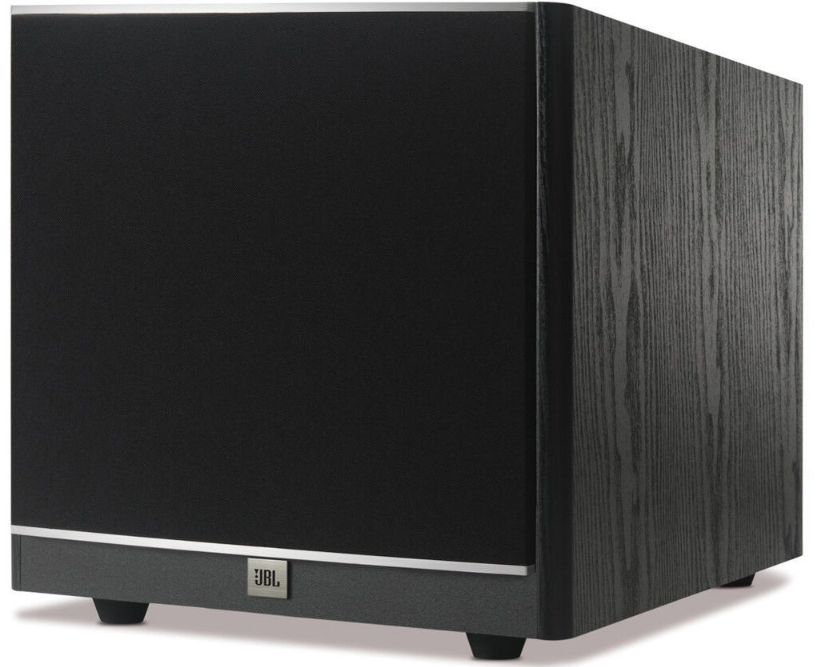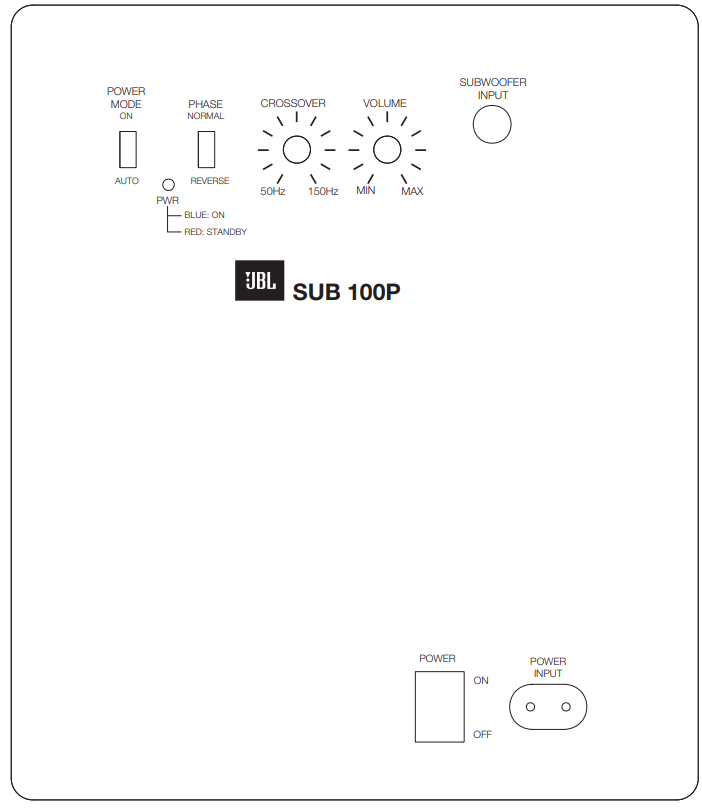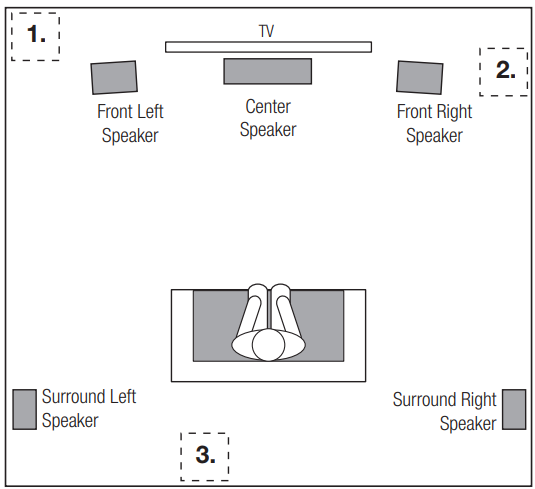Jbl Harman Powered Subwoofer SUB100P User Manual

Content
Introduction
A high-performance transducer and built-in amplifier that deliver the powerful, dynamic and accurate low-frequency performance that makes your film soundtracks and music come alive. And with adjustable crossover, phase controls and automatic turn on/off, it is also simple to connect and set up.
We’re confident that this JBL subwoofer will provide every note of enjoyment that you expect – and that when you think about purchasing additional audio equipment for your home, car or office, you will once again choose JBL products. This quick-start guide contains all the information you need to set up, connect and adjust your new subwoofer. For more in-depth information, go to our web site: https://www.jbl.com
The JBL SUB100P is priced at approximately $299.95.
INCLUDED ITEMS

Specifications
- Power Output: 100 Watts RMS
- Frequency Response: 30 Hz - 150 Hz
- Driver Size: 10 inches
- Input Connectors: RCA, LFE, and High-Level Input
- Crossover Frequency: Adjustable (50 Hz - 150 Hz)
- Dimensions: 12.5 x 13.5 x 15.5 inches
- Weight: Approximately 25 pounds
REAR-PANEL CONTROLS AND CONNECTION

- Power Mode:
When switched to 'Auto' position, the subwoofer will then be in Standby mode. It will automatically turn on when an audio signal is detected and will return to the Standby mode when no audio signal is detected after approximately 10 minutes. Setting this switch to ‘On’ keeps the subwoofer powered until Power Switch is turned 'Off.' - On/Standby LED:
When the Power Switch is in the ‘On’ position, this LED indicates whether the subwoofer is in the On or Standby state.- When the LED glows blue, the subwoofer is turned On.
- When the LED glows red, the subwoofer is in the Standby mode.
- Phase Switch:
This switch determines whether the subwoofer transducer's piston-like action moves in and out in phase with the main speakers. If the subwoofer were to play out of phase with the main speakers, the sound waves from the main speakers could partially cancel out the sound waves from the subwoofer, reducing bass performance and sonic impact. This phenomenon depends in part on the placement of all the speakers relative to the listening position and to each other in the room. - Crossover Control:
This control determines the highest frequency at which the subwoofer reproduces sounds. The higher you set the Crossover control, the higher in frequency the subwoofer will operate and the more its bass will “overlap” that of the speakers. This adjustment helps achieve a smooth transition of bass frequencies between the subwoofer and the speakers for a variety of different rooms and subwoofer locations. - Volume:
Use this control to adjust the subwoofer’s volume. Turn the knob clockwise to increase the volume; turn the knob counterclock-wise to decrease the volume. - Subwoofer (LFE Input):
Connect the subwoofer to the dedicated subwoofer / LFE output of a receiver/processor. - Power Switch:
Set this switch in the ‘On’ position to turn the subwoofer on. If you will be away from home, or will not be using the subwoofer for an extended period, set this switch in the ‘Off’ position to conserve energy. - Power Input:
After you have made and verified the subwoofer’s input connection, plug the power cord into an active, unswitched electrical outlet for proper operation of the subwoofer.
DO NOT plug the power cord into the accessory outlets found on some audio components.
Description
The JBL Harman Powered Subwoofer SUB100P features a robust 10-inch driver that is capable of producing deep, powerful bass. The subwoofer is powered by a 100-watt RMS amplifier, ensuring consistent and reliable performance. It includes multiple input options such as RCA, LFE, and high-level inputs, making it compatible with a variety of audio systems.
The SUB100P also comes with an adjustable crossover frequency, allowing users to fine-tune the bass response to their specific needs. Its compact design makes it easy to place in various rooms without compromising on performance.
PLACING THE SUBWOOFER
The performance of a subwoofer is directly related to its placement in the listening room and its physical position relative to the other speakers in the system. While it is true that in general our ears do not hear directional sounds at the low frequencies where subwoofers operate, when installing a subwoofer within the limited confines of a room, the reflections, standing waves and absorptions generated within the room will strongly influence the performance of any subwoofer system. As a result, the specific location of the subwoofer in the room does become important to the amount and quality of bass that is produced.
For example, placing the subwoofer next to a wall generally will increase the amount of bass in the room; placing it in a corner (1) generally will maximize amount of bass in the room. However, corner placement can also increase the destructive effect of standing waves on bass performance. This effect can vary depending on the listening position – some listening positions may yield very good results while others may have far too much (or too little) bass at certain frequencies.
In many rooms, placing the subwoofer along the same plane as the left and right speakers (2) can produce the best integration between the sound of the subwoofer and that of the left and right speakers. In some rooms, the best performance could even result from placing the subwoofer behind the listening position (3).
We strongly recommend that you experiment with placement before choosing a final location for your subwoofer. One way you can determine the best location for the subwoofer is by temporarily placing it in the listening position and playing music with strong bass content. Move around to various locations in the room while the system is playing (putting your ears where the subwoofer would be placed), and listen until you find the location where the bass performance is best. Place the subwoofer in that location.

CONNECTING THE SUBWOOFER
TO A RECEIVER OR PREAMP/PROCESSOR WITH A LOW-PASS FILTERED DEDICATED SUBWOOFER OUTPUT (LFE)

- Be sure to turn the Crossover on the subwoofer fully clockwise when using this type of connection. This type of setting bypasses the subwoofer’s internal crossover and uses your receiver or processor’s crossover.
- Check your receiver or processor menu settings and set the subwoofer selection to ‘On’ or ‘Yes.’ Please be sure to review the owner’s manual for your receiver or processor for more information on speaker setup and configuration.
TO A RECEIVER OR PREAMP/PROCESSOR WITH PREAMP OUTPUTS

- We recommend setting the subwoofer’s Crossover setting to 80Hz for mid-sized speakers, higher for smaller (satellite) speakers, and lower for larger floorstanding speakers.
OPERATING THE SUBWOOFER
TURNING THE SUBWOOFER ON AND OFF
- Set the subwoofer’s Power Switch to the ‘On’ position.
- Now set the subwoofer’s Power Mode to the ‘Auto’ position. The subwoofer will automatically turn itself on when it receives an audio signal, and it will go into Standby mode after it has received no audio signal for approximately 10 minutes.
- The subwoofer’s LED will glow blue when the subwoofer is on and will glow red when the subwoofer is on Standby.
- If you will not be using the subwoofer for an extended period for instance, if you’re going on vacation set the Power Switch to the ‘Off’ position.
SUBWOOFER ADJUSTMENTS
CROSSOVER
The Crossover control adjusts the subwoofer’s built-in low-pass filter crossover between 50Hz and 150Hz. The higher you set the Crossover control, the higher in frequency the subwoofer will operate and the more its bass will ‘overlap’ that of the speakers. This adjustment helps achieve a smooth transition of bass frequencies between the subwoofer and the speakers for a variety of different rooms and subwoofer locations.
To set the Crossover control, listen for the smoothness of the bass. If the bass seems too strong at certain frequencies, try a lower Crossover control setting. If the bass seems too weak at certain frequencies, try a higher Crossover control setting.
VOLUME
Use the volume control to set the subwoofer’s volume. Turn the knob clockwise to increase the subwoofer’s volume; turn the knob counterclockwise to decrease the volume. Once you have balanced the subwoofer’s volume with that of the other speakers in your system, you shouldn’t have to change the volume control setting.
Notes on Setting Subwoofer Volume:
- Sometimes the ideal subwoofer volume setting for music is too loud for films, while the ideal setting for films is too quiet for music. When setting the subwoofer volume, listen to both music and films with strong bass content and find a ‘middle ground’ volume level that works for both.
- If your subwoofer always seems too loud or too quiet, you may want to place it in a different location. Placing the subwoofer in a corner will tend to increase its bass output, while placing it away from any walls or corners will tend to lessen its bass output.
PHASE
The Phase switch determines whether the subwoofer driver’s piston-like action moves in and out in phase with the speakers. If the subwoofer were to play out of phase with the speakers, the sound waves from the speakers could partially cancel out the waves from the subwoofer, reducing bass performance and sonic impact. This phenomenon depends in part on the placement of all the speakers relative to each other and the listener(s) in the room.
Although in most cases you should leave the Phase switch in the ‘Normal’ position, there is no absolutely correct setting for the Phase switch. When the subwoofer is properly in phase with the speakers, the sound will be clearer and have maximum impact, and percussive sounds like drums, piano, and plucked strings will sound more life-like. The best way to set the Phase switch is to listen to music that you know well and to set the switch in the position that gives drums and other percussive sounds maximum impact.
USING THE SUPPLIED CARPET SPIKES
Four metal spikes are supplied for use when you place the subwoofer on a carpeted surface. Do not use these spikes when placing subwoofer on non-carpeted surfaces.
To insert the spikes:
- Gently lay the subwoofer on its side (not its front or back) on a soft, nonabrasive surface.
- Screw each spike into the threaded insert in each foot. Make sure all four spikes are screwed in completely for stability.
Note: NEVER drag the subwoofer to move it. Always carefully lift the subwoofer and carry it to its new location.
Setup Guide
To set up the JBL Harman Powered Subwoofer SUB100P,
- Start by placing it in a corner of the room to maximize bass response.
- Connect the subwoofer to your audio system using the appropriate input connectors (RCA, LFE, or high-level inputs).
- Adjust the crossover frequency to blend the subwoofer’s output with your main speakers.
- Turn on the subwoofer and adjust the volume and phase controls to optimize the sound.
- You may need to experiment with different settings to find the best balance for your specific setup.
Troubleshooting
If you encounter any issues with your JBL Harman Powered Subwoofer SUB100P, here are some common problems and solutions:
- No Sound: Check that the subwoofer is turned on and that all connections are secure. Ensure that the volume is not muted.
- Adjust the crossover frequency or reduce the volume to avoid overdriving the subwoofer.
- Ensure proper ventilation around the subwoofer and avoid placing it in enclosed spaces.
Always refer to the user manual for specific instructions and warnings.
Harman Powered Subwoofer SUB100P Pros & Cons
Pros
- Compact and lightweight design for easy placement.
- Powerful 100-watt RMS amplifier for robust bass output.
- Adjustable crossover frequency for customizable sound.
- Multiple input options for compatibility with various audio systems.
- Affordable price point compared to other high-performance subwoofers.
Cons
- May not be as powerful as larger subwoofers.
- No wireless connectivity option.
Customer Reviews
Customers have praised the JBL Harman Powered Subwoofer SUB100P for its clear and deep bass response, making it a great addition to home theaters and music systems. Some users have noted that it is relatively easy to set up and adjust. However, a few reviewers have mentioned that it might not be as powerful as more expensive subwoofers.
Common complaints
Including the lack of wireless connectivity and some users finding the design less appealing than other models.
Faqs
What is the power output of the Subwoofer?
What are the input connectors available on the JBL SUB100P?
Can I adjust the crossover frequency on the JBL Harman?
How do I optimize the placement of the JBL?
Why is my JBL Harman Powered Subwoofer overheating?
How do I troubleshoot if there is no sound coming from my JBL Harman Powered Subwoofer SUB100P?
Is the JBL Harman SUB100P suitable for professional audio setups?
What are some common issues with the JBL?
How does the Subwoofer compare to other subwoofers in terms of price?
Leave a Comment
